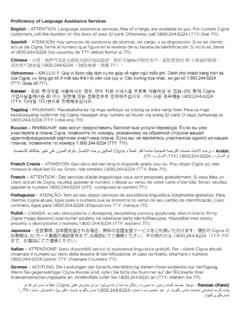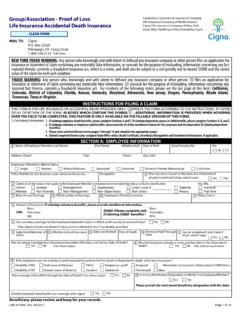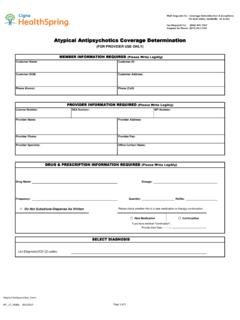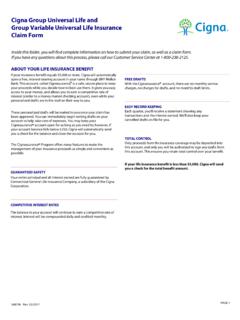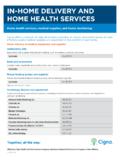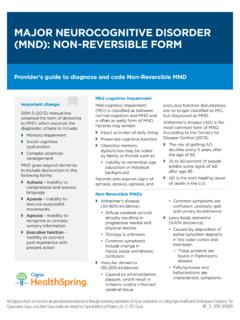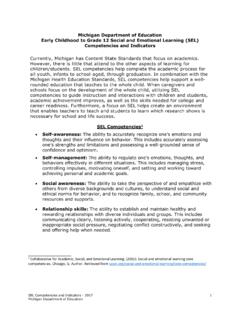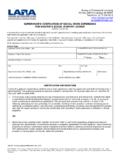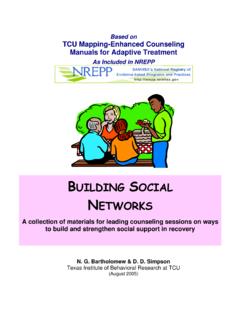Transcription of Social Skills - Cigna
1 Social Skill Intervention Strategies for Children with AutismMegan BaileyClinical Interventionist 2007 SARRCA utism Autism Spectrum Disorders (ASDs) Most prevalent childhood developmental disorder in the 1 in 110 children are affected by ASD 1 in 110 children are affected by ASD Most prevalent developmental disorder in the US 4 males: 1 female In Arizona in 2002 the median age of diagnosis for autism was 5 years 3 months 2007 SARRCA utism Autism is a pervasive developmentaldisorder in which excesses and deficitsin behavior are observed that have a neurological basis. DSM-IV; 3 areas of impairment: 1. Social interaction. 2. Communication. 3. Restricted and repetitive behavior. 2007 SARRCA utism Spectrum DisordersSocialCommunicationRestrictive/ Repetitive Behavior 2007 SARRCR esearch on Social Development Without support, children with ASD may have difficulty: Starting up a conversation Invite kids over to play Go to parties Joining activities Keeping up with the game or understanding the rules Lack of Social relationships in childhood may lead to: Decreased employment Decreased independent living Decreased life expectancy Severe mental health problems (depression, suicidal ideation, anxiety)(Strain, 1991; Wing, 1981.)
2 Strain & Schwartz, 2001) 2007 SARRCR elationships/Friendships Provide continuous, stable relationships with familiar peers Bolster self-worth, sense of belonging Provide companionship, affection, emotional support Create opportunities to share hopes, fears, and interests Help us learn about the Social world outside our families and self 2007 SARRCS kills Necessary for Friendship Sharing Ability to compromise Consider another person s perspective Companionship Empathy Conflict Resolution Reliability Ability to exchange feelings(Asher, Parker, & Walker, 1998) 2007 SARRCR esearch Related to ASD and Social Skill Development Physically integrating students alone may not be enough (Gresham, 1984; Kamps et al., 1998) Students with disabilities considered least liked (Sale & Carey, 1995) Incidence of peer victimization (Shtayermman, 2007; Little, 2002) High levels of bullying Peer shunning Not invited to birthday parties Eating alone at lunch Picked last for teams 2007 SARRCR esearch Directly Related to Recess, Lunch and Unstructured Time Increased (Nelson et al.
3 , 2007) isolation low engagement Less likely to initiate Social interactions(Hauck, Fein, Waterhouse, & Feinstein, 1995) May not respond (appropriately) to initiations by peers (Lee, Odom, & Loftin, 2007) 2007 SARRCThe 2007 SARRCS ocial Skills -Intervention Approach Use treatment approaches based on the principles of Applied Behavior Analysis as appropriate for each child s needs Promote healthy relationships Peer sensitivity/disability awareness to promote awareness and understanding through student education and emersion 2007 SARRCE ffective Social Skills Interventions Occur across multiple naturalistic settings (Bellini, Peters, Benner, & Hopf, 2007) Peer mediated(Harper, Symon, & Frea, 2008; Kamps et al., 1992; Kohler et al., 2007; Owen-DeSchryver et al., 2008) Frequent(Bellini, Peters, Benner, & Hopf, 2007; Strain & Schwartz, 2001) Motivating and child directed(Kern at al.
4 , 1998; Koegel, Dyer, & Bell, 1987; Koegel et al., 2005) Include cooperative arrangements(Kennedy & Itkonen, 1996; Koegel et al., 2005) Mutually reinforcing(Koegel, Werner, Vismara, & Koegel, 2006) 2007 SARRCB enefits For Those with ASD Increased: Peer initiations (Kalyva & Avramidis, 2005; McGee et al., 1992; Owen-Des Schryver et al., 2008) Reciprocal interaction (initiations & responses)(Harper, Symon & Frea, 2008; Kamps et al., 2002; Kalyva & Avramidis, 2005; Kohler et al., 1997; Kohler et al., 2007; McGee et al., 1992) Peer acceptance(Kamps et al., 2002; McGee et al., 1992) Participation in community or after school activities (Goldstein, Schneider, & Thiemann 2007) Opportunities to practice and generalize Skills (Laushey and Heflin, 2000) Engagement(Kamps et al., 2002) Decreased: Stigmatizing behaviors (Lee, Odom, & Loftin, 2007) 2007 SARRCS ocial Skills : SupportsPeer Sensitivity TrainingTypical peers are supported so they develop Skills and learn how to interact appropriately and, most importantly, develop meaningful relationships with dignity and respect as equal members of the school community.
5 2007 SARRCT ypes of Social Interactions Observing (proximity to peers) Parallel Play Responding to initiations of peers Cooperative Play Initiating with peers 2007 SARRCO bserving (proximity to peers) Watching peers complete an activity standing near or in the middle of a soccer game that is occurring without actually participating 2007 SARRCP arallel Play Completing the same play activity as peers separately but within close proximity drawing with chalk; digging in the dirt 2007 SARRCR esponding Responding (verbally or physically) to the initiation of a peer A peer asks a child for a toy and the child gives the peer the toy A peer asks a child what she wants to play and the child responds game 2007 SARRCC ooperative Play Completing a play activity WITH peers Digging a whole in the sand with peers Taking turns playing hopscotch Playing tag with peers Talking to a peer about the soccer game they are watching 2007 SARRCI nitiating Starting a Social interaction with peer(s) Asking to join a game Asking a peer if they want to play 2007 SARRCPLAYGROUND PROGRAMS etting up a Social Skills Intervention Program 2007 SARRCG etting Started 1.
6 Assess to identify strengths and deficits2. Identify goals3. Intervention4. Collect data to monitor and evaluate progress5. Teach across all settings (Generalization) 2007 SARRCR ecognize the Need Data-driven decision-making Assessment of student Collect baseline data IEP Specific goal Specific service-delivery 2007 SARRCA ssessment for Social Skills training Objectives: To determine what Social Skills need to be addressed To determine what would be the most effective teaching strategies To determine the most effective teaching modalitiesBaker, 2001 2007 SARRCA ssessment Strategies Teacher Checklist Parent Interview Student Interview Observation 2007 SARRCIEP- Social Skills GoalShould be individualized to the needs and abilities of each student contingent on baseline IEP Goal:Student will interact with typical peers 85% of the time during recess, lunch and other less structured times of the day.
7 2007 SARRCS ample Goals Child A Increase appropriate initiations with peers: Child A will appropriately initiate with two peers during a recess across three consecutive days. Increase duration of engagement within large group activities Child A will engage with five or more peers in a structured group activity ( red light green light, soccer). Child B Decrease prompts to engage in activities: Child B will engage in an appropriate recess activity for ten minutes with no more than two prompts from an adult. Child C Increase cooperative play with peers during group activities: Child C will turn take with peers without displaying challengingbehaviors 4 out of 5 opportunities for three consecutive days. Child D Develop appropriate behavior when loses a game: Child D will not display challenging behaviors after losing a game 4 out of 5 opportunities for three consecutive days.
8 2007 SARRCS ocial Skills training -Examples of What to teach Sharing and turn taking Initiating interactions Responding appropriately to greetings and play initiations Bringing up appropriate topics and reciprocal conversations Attention to facial expressions and body language Respecting personal boundaries and space Eye contact Appropriate comments and questions Ask about others interests and listen 2007 SARRCT aking Baseline Data Measures-Specific to goals of students Social Initiations with peers (frequency) Time engaged with peers (duration/percentage) Responses to peer initiations (percentage) What is baseline? Recording the current levels of each behavior being measured Do not need to remove any supports provided on the playground; continue to provide same level of support on playground 2007 SARRCB aseline 2007 SARRCS teps for Effective Social Skills Intervention Program 2007 SARRCP rovide Structure Set up structured activity/prompt peers to invite target children to join Set up red light green light Help facilitate students picking teams for kickball Use chalk to play Pictionary 2007 SARRCF ollow the Child s Lead First need to find out what the target students like to play Use preferred activities to create opportunities to play with peers Plan activities for the day with the flexibility of being able to follow the motivation of the targeted child Student wants to play with a Frisbee so you set up Frisbee golf 2007 SARRCC reate Opportunities Provide opportunities within activity for children to interact with one another at the level appropriate for that child If a child prefers an
9 Activity, give that activity to a peer so the child can initiate with the peer If a child wants to play a game, put them in charge of the game so peers will initiate with that child Set up new activities similar to other preferred activities to expand play set up a cooperative arrangement within an activity building a castle in the sand box 2007 SARRCP rovide Support Contact target student within activity as needed Within activity provide verbal and gestural prompts as needed to help the child complete the activity Prompt the child to ask others to play a game ( we need more people to play, go ask three friends ) Provide support to peers teaching them how to interact with peers with Social deficits prompt them to ask a target peer to play prompt a peer to tell a target peer when it is their turn If a targeted peer does not respond to a child s initiate, provide support to that child to keep asking until they get a response 2007 SARRCREINFORCE GOOD BEHAVIORS Immediately reinforce (provide preferred item/praise, etc) appropriate Social behaviors within activity for both target andtypical students (within 5 sec of the behavior) Need to reinforce appropriate behavior of both the typical peersand the targeted child to increase behavior in the future When possible, want the reinforcement for their behavior to come from each other (natural contingencies) Set up bean bag toss where asking your peer for the bean bag (behavior)
10 Gives you access to the bean bag (reinforcement) 2007 SARRCP ositive Practice Provide prompting for socially appropriate behavior as needed and set up opportunities to practice socially appropriate behavior for both target and typical students If a child is taking a toy from a peer, set up the opportunity again and tell the child to ask the peer for the toy. When the child asks, have the peer give the toy to the child for a turn. Provide praise immediately to the peer and after the child takes his/her turn have him/her return the toy to the peer. 2007 SARRCI ntervention 2007 SARRCR esults of Piloting Playground Program at Schools 2007 SARRCP ilot Data Pilot Data May 2008 Engagement with Peers during RecessTime Engaged with Peers Kindergarden through 4th Grade 020406080100 Student 1 Student 2 Student 3 Student 4 Percentage of Time BaselineWeek 2 Week 16 2007 SARRCP ilot Data Pilot Data May 2008 Interactions with Peers during RecessInteractions with Peers during 1 Student 2 Student 3 Student 4Fr equency per Mi nut eInteractions BaselineInteractions Week 2 Interactions Week 8 2007 SARRCP ilot Data May 2008 Initiations with Peers on PlaygroundSocial Initiations Kindergarden through 4th 1 Student 2 Student 3 Student 4 Frequency per Minute BaselineWeek 2 Week 16 2007 SARRCA dditional Recommendations and Resources included in Handout Preschool and Elementary Middle and High School Research articles and Related
